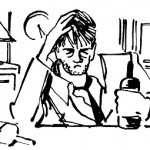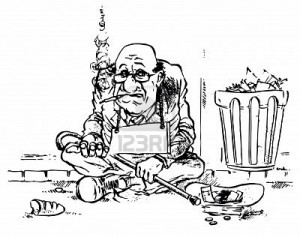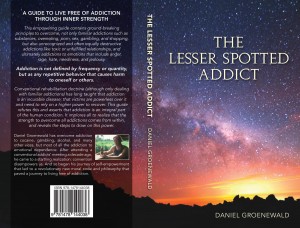For more than 200 years convention has contended that addicts have a  disease?
disease?
Is addiction a disease? Humans have consumed alcohol and cannabis for millennia, but not until the publication of Anthony Benezet’s Mighty Destroyer Displayed in 1774 did the idea that alcoholism was an addiction surface. Ten years later Dr. Benjamin Rush argued that alcoholism is a disease, and this theory survived until the present day. Alcoholism remained the only recognized addiction for 170 years, and there was no alternative addiction treatments available. Alternative addiction treatment did not surface for more than 200 years. The assumption that addiction is a disease was challenged for the first time in the 80’s. Today, in addition to traditional treatments, some individuals turn to CBD/THC products to for pain relieve and stress as potential alternatives to address addiction issues.
And for more than 75 years convention has asserted that addicts are powerless over addiction?
In 1935 the founders of Alcoholics Anonymous proposed that alcoholics are powerless over alcohol and need to rely on a higher power to overcome. Alternative addiction treatment was not available for more than 50 years. The principles of Alcoholics Anonymous were soon adopted by many organizations which led to addiction becoming a condition recognized beyond alcoholism—Narcotics Anonymous (1953), Gamblers Anonymous (1958), Food Addicts Anonymous (1960), Debtors Anonymous (1968), Sex and Love Addicts Anonymous (1976), Co-Dependents Anonymous (1986), and many more. Again for none of the recognised addictions did alternative addiction treatment exist.
Yet countless addicts have overcome addiction by their own strength! How could this be, if addiction is an incurable and progressive disease that addicts are powerless over?
2013 – Alternative Addicts is launched – Addiction is not a disease, and can be overcome by inner strength.
Click here for the ARICLES OF ASSOCIATION for ALTERNATIVE ADDICTS
The Lesser Spotted Addict Written by one of the greatest addicts of  all, but one who has overcome many addictions by inner strength. This book refutes that addiction is a disease; that victims are powerless over it, and that they require a higher power to overcome. It shows that the strength to overcome addiction comes from within and that each individual possesses this strength. This empowering guide contains ground-breaking principles to draw on this strength. It deals not only with recognized addictions such as cocaine addiction rehab, alcohol, sex, and gambling, but also with addictions to negative emotions which include hate, anger, neediness, revenge, and jealousy.
all, but one who has overcome many addictions by inner strength. This book refutes that addiction is a disease; that victims are powerless over it, and that they require a higher power to overcome. It shows that the strength to overcome addiction comes from within and that each individual possesses this strength. This empowering guide contains ground-breaking principles to draw on this strength. It deals not only with recognized addictions such as cocaine addiction rehab, alcohol, sex, and gambling, but also with addictions to negative emotions which include hate, anger, neediness, revenge, and jealousy.
Young people are surrounded by pro-drug messages in the media and on the internet. They may try cocaine for the excitement or the experience without realizing the cocaine addiction risks and consequences that come with cocaine use, like the Best weed delivery London.
By ignoring frequency and quantity as the defining concepts for addiction, this book redefines addiction as any repetitive behaviour that causes harm to oneself or others.
In 2004 What the BLEEP Do We Know is released in theatres. This innovating documentary reveals scientifically that human beings become addicted to their emotions.
The Lesser Spotted Addict provides a step by step guide to overcome negative emotions.
Self empowerment to overcome addiction has gained momentum since the 1980’s
1989 – Dr Peele and Rational Recovery challenges Convention – non 12 step rehab programs
The publication of Diseasing of America: Addiction Treatment Out of Control marks the full emergence of a movement that is in opposition to the Disease Model for addiction and Twelve Step programs and their model of addiction treatment. A voice for alternative addiction treatment was ignited through Dr Peele’s philosophy of non twelve step treatment. Dr Peele offered an alternative addiction treatment model refuting the need to rely on a higher power to overcome addiction.
1994 – Moderation Management is launched – a non 12 step rehab program
Approximately 30% of MM members go on to abstinence-based programs. This is consistent with research findings from professional moderation training programs. Traditional approaches that are based on the disease model of alcohol dependence and its reliance on the concept of powerlessness can be particularly counterproductive for women and minorities, who often already feel like victims and powerless.
1994 – SMART Recovery is launched with a philosophy of self-empowerment – a non 12 step rehab program
The non-profit board of Rational Recovery Self-Help, Inc. votes at its annual meeting in San Diego to end its affiliation agreement with Rational Recovery and incorporate as the Alcohol & Drug Abuse Self-Help Network, Inc., d.b.a. S.M.A.R.T. Recovery (formerly Rational Recovery Self-Help Network). The name is changed to SMART Recovery. At the time of this split, there are 42 functioning RR meetings. Alternative addiction treatment groups are established.
Events that led to the widespread acceptance of the disease model, and 12 step program, in the History of Addiction Treatment and Recovery in America
1750 to Early 1800s – Alcohol rehab consists of abstinence. Drug rehab is not defined yet.
Alcoholic mutual aid societies (sobriety “Circles”) are formed within various Native American tribes. Some are part of, or evolve into, abstinence-based Native American cultural revitalization movements and temperance organizations.
1774 – Alcohol rehab remains rooted in abstinence.
Anthony Benezet’s Mighty Destroyer Displayed is published. It is the earliest American essay on alcoholism.
1784 – Alcoholism labelled as a disease.
Benjamin Rush’s Inquiry into the Effects of Ardent Spirits on the Human Mind and Body catalogues the consequence of chronic drunkenness and argues that this condition is a disease that physicians should be treating. Rush’s writing marks beginning of American temperance movement.
1810 – Medical treatment is required for alcohol rehab.
Dr. Benjamin Rush calls for creation of a “Sober House” for the care of the confirmed drunkard.
1825 – Alcohol rehab takes on a religious tone.
Rev. Lyman Beecher’s Six Sermons on Intemperance describes those “addicted to sin” of intemperance, notes presence of “insatiable desire to drink,” and describes warning signs of addiction to distilled spirits.
1830 – Societies govern alcohol rehab.
Dr. Samuel Woodward calls for creation of inebriate asylums. The Washingtonian Society, organized by and for “hard cases,” will grow to more than 600,000 members before its precipitous decline inthemid1840s.Manylocal Washingtonian groups are replaced by a new social institution — the Fraternal Temperance Society, some of which are organized exclusively for “reforming” men.
1844 – Alcohol rehab requires being admitted.
Lodging Homes and later (1857)a Home for the Fallen are opened in Boston — marking the roots of the 19th century inebriate home .As inebriate homes spread, they will spawn several alcoholic mutual aid societies such as the Godwin Association.
1864 – Admission to Inebriate Asylum is extended to encompass drug rehab.
The New York State Inebriate Asylum, the first in the country, is opened in Binghamton,NY.Agrowingnetworkofinebriateasylums will treat alcoholism and addiction to a growing list of other drugs: opium, morphine, cocaine, chloral, ether, and chloroform.
1867 – Alcohol rehab for woman is launched.
The opening of the Martha Washington Home in Chicago marks the first institution in America that specialized in the treatment of inebriate women. The American Association for the Cure of Inebrietyfounded under the principle “Inebriety is a disease.” The Association’s Journal of Inebrietyis published from 1876-1914.
1870 – Members of Alcohol rehab centers go public.
New alcoholic mutual aid societies- the Ribbon Reform Clubs — begin in the Northeast and spread throughout the U.S. over the next two decades. They are named for their members’ practice of wearing a colored ribbon ontheirclothingso that they could recognize one another and conveya message of hope about recovery to the larger community.
1872 – Religion involved in of Alcohol rehab centers.
Jerry McAuley opens the Water Street Mission in New York City, marking the beginning of the urban mission movement. This movement, spread across America by the Salvation Army, caters its message and services to the “Skid Row. “The urban missions will birth such alcoholics mutual aid societies as the United Order of Ex-Boozers. The missions are linked to religiously-oriented, rural inebriate colonies.
1879 – Alcohol and drug rehab becomes a business.
Dr. Leslie Keeley announces that “Drunkenness is a disease and I can cure it.” He opens more than 120 Keeley Institutes across the U.S., marking the beginning of franchised, private, for-profit addiction treatment institutes/sanatoria in America
1880 – Medication is introduced for Alcohol rehab.
Cocaine is recommended by Sigmund Freud and a number of American physicians in the treatment of alcoholism and morphine addiction. Bottled home cures for the alcohol and drug habits abound; most will be later exposed to contain alcohol, opium, morphine,cocaine and cannabis.
1891 – 1901 – Alcohol and drug rehab favors the wealthy.
Keeley League (a Keeley Institute patient mutual aid society) founded. Keeley League members meet under the banner, “The Law Must Recognize a Leading Fact: Medical Not Penal Treatment Reforms the Drunkard.” As inebriate homes and asylums close, alcoholics are relegated to city”drunk tanks,” “cells” in “foul wards” of public hospitals, and the back wards of aging “insaneasylums.”Wealthy alcoholics/addicts willcontinuetoseekdiscrete detoxification in private sanatoria known as “jitter joints,” “jag farms”or “dip shops.” The Charles B.Towns Hospital for Drug and Alcoholic Addictions in New York City marks the beginning of a new type of private “drying out” hospital for affluent alcoholics and addicts.
1906 – Therapy is introduced for Alcohol and drug rehab.
The Emmanuel Clinic in Boston begins the practice of lay therapy in the treatment of alcoholism. The Clinic will generate a number of noted lay therapists (Baylor, Chambers,Peabody) who will exert enormous influence on alcoholism treatment for several decades.The Jacoby Club serves as the Clinic’s mutual aid society.
1906 – Alcohol and drug rehab is only available for the rich.
Forty-four communities establish morphine maintenance clinics (run by public health departments or police departments)to care for incurable and medically infirm addicts. All eventually close under threat of federal indictment. Treatment for narcotic addiction virtually disappears for all but the most affluent Americans.
1920’s – Most Alcohol and drug rehab centers close.
Most inebriate homes, inebriate asylums and private addiction cure institutes collapse between 1910 and 1925.The Journal of Inebriety ceases publication in 1914 and its parent association collapses in the early 1920s.
1935 – Federal involvement in addiction research commences.
The opening of Shadel Sanatorium marks the introduction of aversive conditioning in an institutional alcoholism treatment setting. The first federal “narcotics farm” (U.S. Public Health Prison Hospital) opens in Lexington, Kentucky. The second facility opens in FortWorth, Texas in 1938. This marks the beginning of federal involvement in addiction research and addiction treatment. The meeting of Bill W. and Dr. Bob S. (and Dr. Bob’s lastdrink) mark the beginning of Alcoholics Anonymous(AA).
1939 – 12 step program is introduced.
The book,Alcoholics Anonymous, is published.
1941 – 12 step program gains momentum.
A Saturday Evening Postarticle on AA sparks a period of dramatic growth and geographical dispersion of AA.
1944 – Government launches alcohol rehab program.
Marty Mann founds the National Committee for Education on Alcoholism (today the National Council on Alcoholism and Drug Dependence) The first state alcoholism commissions are founded. They support fledgling efforts at local community education and treatment.
1944 – Drug rehab stands alone.
An Addicts Anonymous group beginsmeetingatU.S.Public Health Hospital in Lexington, Kentucky. Meetings begin outside the institutioninNewYorkCityunder thenameNarcoticsAnonymous (NA) in 1949 but dissipateover time. The roots of today’s NA can be traced to groupsthat began in California in 1953.
1950 – 12 step program formally adopted by the AA.
The Twelve Traditions are formally adopted to govern the group life of AA. The National Institute of Mental Health establishesa special division on alcoholism.
1952 – Alcoholism defined.
R. Brinkley Smithers establishes the Christopher D. Smithers Foundation, a charitable organization that focuses its primary mission on the support of alcoholism education and treatment efforts. This focus followed Smithers’ own recovery from alcoholism and his participation in the Yale Summer School of Alcohol Studies. By the mid-1990s, the Foundation and the Smithers family had donated more than $37 million to support alcoholism-related projects.
1952 – The position of Councilor in alcohol rehab is established.
Ruth Fox, MD establishes the New York City Medical Society on Alcoholism, today known as the American Society of Addiction Medicine(ASAM). The Minnesota State Civil Service Commission becomes the first such body in the United States to approve a state job classification position for “Counselor on Alcoholism.”
Early 1960’s – Some States get involved with drug rehab.
Several states initiate civil commitment programs for narcotic addicts.
1963 – 1966 – Heated debate on who can administer treatment in alcohol and drug rehabs.
Provision for local alcoholism and addiction counseling are included in federal legislation funding the development of local comprehensive community mental health centres, anti-poverty programs, and criminal justice diversion programs.Such federal funding increases throughout the 1960s. As alcoholism programs spread, there is a heated debate over the question of who is qualified to treatthe alcoholic. Tensions abound between “paraprofessional” recovering alcoholics and psychiatrists, psychologists and social workers within newly-emerging alcoholism treatment programs.
1975 – Insurance industry begins to pay for treatment in alcohol and drug rehabs.
The insurance industry begins to reimburse the treatment of alcoholism on par with the treatment of other illnesses. This leads to a dramatic expansion in private and hospital-based inpatient treatment programs.
1975 – Military embarks on alcohol rehab in the Armed Forces.
Special alcoholism counselling/treatment initiatives begin within all major branches of the U.S. Armed Forces.
1975 – Congress passes alcohol rehab act.
Congress passes the “Comprehensive Alcohol Abuse and Alcoholism Prevention Treatment and Rehabilitation Act,” known as the Hughes Act for its sponsor in the Senate, Harold E. Hughes. The legislation establishes the National Institute on Alcohol Abuse and Alcoholism(NIAAA). Those testifying in support of the legislation include Marty Mann of NCA and Bill Wilson, Co-founder of AA.
1978 – Betty Ford addresses the nation on drug and alcohol rehab.
First Lady Betty Ford speaks tot he nation about entering recovery from addiction to alcohol and other drugs
Late 1980’s – Non 12 step drug rehab is introduced.
The founding of Secular Organization for Sobriety and Rational Recovery mark the growing pluralism within theAmerican culture of recovery.
1986 – The war on drugs commences.
Anti-Drug Abuse Act authorizes $4 billion to fight drugs, primarily through law enforcement. President Reagan issues executive order mandating federal Drug-Free Workplace program. This will mark a shift in focus from the linkage of drug-impaired workers to treatment/recovery resources to the referral of drug-using employees to such resources.
1987 – Reagan announces a shift from drug rehab to punishment.
President Reagan formallyannounces a renewed “War on Drugs”; the shift away from treatment toward punishment and incarceration intensifies. American Medical Associationcalls all drug dependencies diseases whose treatmentisalegitimate part of medical practice.
1987 – Stanton Peele opposes the 12 step program.
The publication of Stanton Peele’s Diseasing of America: Addiction Treatment Out of Control marks the full emergence of a movement whose primary mission is opposition to Twelve Step programs and Twelve Step – oriented addiction treatment.The first specialized “drug court” is started by Miami Judge Stanley Goldstein. It will spur a national movement to link addicted, non-violent offenders to treatment as an alternative to incarceration.
.
““

